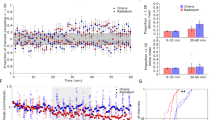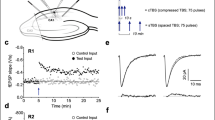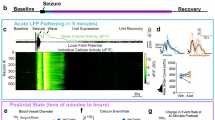Abstract
ONE of the most intriguing electrophysiological phenomena observed in the central nervous system is the persistent enhancement of an evoked synaptic response following brief trains of electrical stimuli. Within the hippocampus, evoked synaptic potentials can be doubled or tripled by tetanising stimulation, and such changes persist for hours to weeks1–6. Interest in the phenomenon of long term potentiation (LTP) stems from the generally held belief that synaptic plasticity of this sort may well be a physiological basis of information storage in the CNS. It is notable that this striking synaptic plasticity is observed in a structure which extensive clinical and experimental evidence suggests has a central role in information storage and/or retrieval7–11. Included in this evidence are numerous demonstrations that disrupting hippocampal activity by electrically induced epileptiform seizures also disrupts memory formation and/or retrieval12–15. In addition, the effectiveness of a variety of other treatments in disrupting behavioural plasticity seems closely related to their ability to elicit convulsive activity in the hippocampus16,17. We report here a series of experiments indicating that LTP established in the hippocampus can also be reversibly disrupted by the same kind of convulsive activity which disrupts memory functions. Specifically, we have produced LTP in the CA1 pyramidal cell synaptic field, disrupted it with electrically induced hippocampal seizures, and subsequently reinstated it with low frequency tetanic stimulation.
This is a preview of subscription content, access via your institution
Access options
Subscribe to this journal
Receive 51 print issues and online access
$199.00 per year
only $3.90 per issue
Buy this article
- Purchase on Springer Link
- Instant access to full article PDF
Prices may be subject to local taxes which are calculated during checkout
Similar content being viewed by others
References
Bliss, T. V. P., and Gardner-Medwin, A. R., J. Physiol., Lond., 232, 357–374 (1973).
Bliss, T. V. P., and Lømo, T., J. Physiol., Lond., 232, 331–356 (1973).
Douglas, R. M., and Goddard, G. V., Brain Res., 86, 205–215 (1975).
Andersen, P., Teyler, T. J., and Wester, K., Acta Physiol. Scand. Supp., 396, A38 (1973).
Schwartzkroin, P. A., and Wester, K., Brain Res., 89, 107–119 (1975).
Alger, B. E., and Teyler, T. J., Brain Res., 110, 463–480 (1976).
Kimble, D. P., Kirkby, R. J., and Stein, D. G., J. comp. Physiol. Psychol., 61, 141–143 (1966).
Douglas, R. J., Psychol. Rev., 67, 416–442 (1967).
Scoville, W. B., and Milner, B., J. Neurol. Neurosurg. Psychiat., 20, 11–21 (1957).
Isaacson, R. L., The Limbic System (Plenum, New York, 1974).
Isaacson, R. L., and Pribram, K., The Hippocampus, Vol. 2: Neurophysiology and Behavior (Plenum, New York, 1975).
McGaugh, J. L., and Gold, P. E., in Neural Mechanisms of Learning and Memory (edit. by Rosenzweig, M. R., and Bennett, E. L.), 549–560 (MIT Press, Cambridge, 1976).
McGaugh, J. L., and Herz, M. J., Memory Consolidation (Albion, San Francisco, 1972).
Kesner, R. P., and Wilburn, M. W., Behav. Biol., 10, 259–293 (1974).
Kesner, R. P., Dixon, D. A., Pickett, D., and Berman, R. F., Neuropsychologia, 13, 465–480 (1975).
Nakajima, S., in The Hippocampus, Vol. I: Structure and Development (edit. by Isaacson, R. L., and Pribram, K.), 393–414 (Plenum, New York, 1975).
Gibbs, M. E., and Mark, R. F., Inhibition of Memory Formation (Plenum, New York, 1973).
Van Harreveld, A., and Fifkova, E., Expl Neurol., 49, 736–749 (1975).
Cherkin, A., Eckardt, M. J., and Gerbrandt, L. K., Science, 193, 242–244 (1976).
Van Harreveld, A., and Fifkova, E., Brain Res., 81, 455–467 (1974).
Van Harreveld, A., and Khattab, F. I., J. Neurophysiol., 30, 911–929 (1967).
Author information
Authors and Affiliations
Rights and permissions
About this article
Cite this article
HESSE, G., TEYLER, T. Reversible loss of hippocampal long term potentiation following electroconvulsive seizures. Nature 264, 562–564 (1976). https://doi.org/10.1038/264562a0
Received:
Accepted:
Published:
Issue Date:
DOI: https://doi.org/10.1038/264562a0
This article is cited by
-
Electroconvulsive therapy-induced volumetric brain changes converge on a common causal circuit in depression
Molecular Psychiatry (2024)
-
Links between electroconvulsive therapy responsive and cognitive impairment multimodal brain networks in late-life major depressive disorder
BMC Medicine (2022)
-
Electroconvulsive therapy, electric field, neuroplasticity, and clinical outcomes
Molecular Psychiatry (2022)
-
Tau- but not Aß -pathology enhances NMDAR-dependent depotentiation in AD-mouse models
Acta Neuropathologica Communications (2019)
-
Relationship Between Hippocampal Volume, Serum BDNF, and Depression Severity Following Electroconvulsive Therapy in Late-Life Depression
Neuropsychopharmacology (2016)
Comments
By submitting a comment you agree to abide by our Terms and Community Guidelines. If you find something abusive or that does not comply with our terms or guidelines please flag it as inappropriate.



